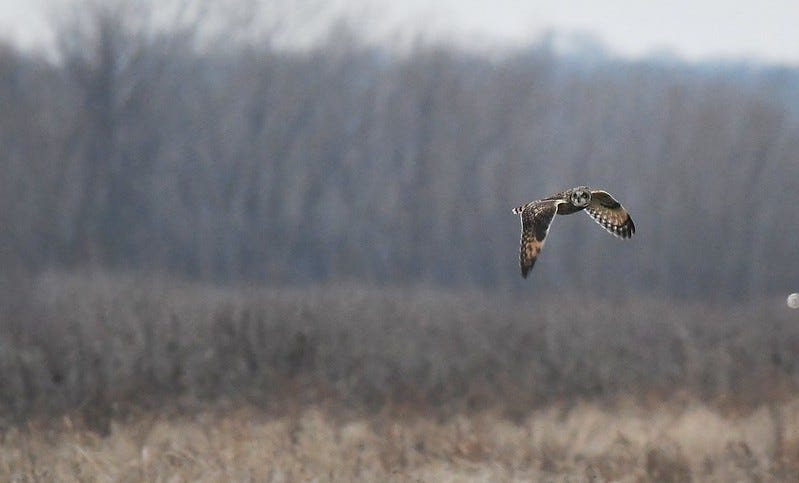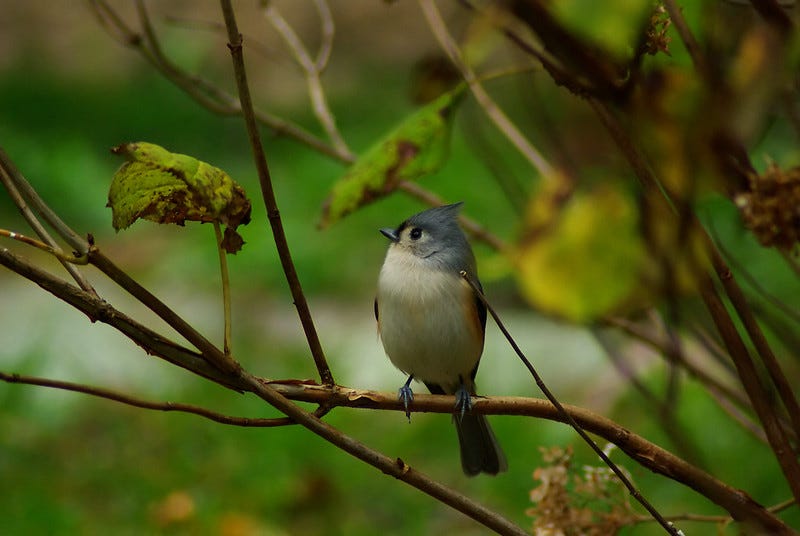Birding Western Mass: Special Owls, Mini-Flocks, a marsh with a paved path
Thoughts on Birding from the Quabbin to the Berkshires
Study Up
Short-eared owls should start to appear this time of year. All years are unusual now, so we can’t assume that will be true — and as I write this, few or no sightings are reported yet on eBird or in the FB group. But sightings historically start to appear infrequently in November, then more often in December, and then much more often (but not super-often) in January. By March, sightings will fall away again.

Owls catch our attention for many reasons. Their binocular vision gives them faces that their feather patterns add apparent (but not true) emotions to. When they look at us we feel observed. (I suspect they feel the same.) They hunt silently and we associate their calls with the evening and the night. Off and on over the years I have focused evenings and days on seeking owls. I recommend Pat and Clay Sutton’s book How to Spot an Owl without reserve.
Studying your short-eareds is different from studying birds that look a lot like others. While you might find it hard to tell owls apart initially, a quick review of size and behavior and habitat will ease that.
It’s more studying where you could see them. To plan to see a short-eared, you’ll probably have to go somewhere you usually don’t … at a time you might rather not … using a method that may not be your first choice. The good news is that a short-eared owl is easy to distinguish. It flies low; its fluttery wingbeats are diagnostic (that means when you see it flap, you’ll know what you’re looking at); its habitat is particular. (Snowy owls use a similar habitat, but they’re really white and they are way more visible at a different time of day.)
So here’s your short-eared list of things to know:
Go where they are. In Western Mass, that’s the riverbed sites in the middle of the zone, including especially Arcadia, Arcadia Meadows (although FYI I couldn’t get to the Arcadia Meadows a few days ago because of some flooding), the East Meadows, and The Honey Pot. Also, Southwick WMA is a strong location — thanks almost entirely to Dorrie Holmes’ vigilance.
Go when they are flying around. In my experience and in the literature, they are described as crepuscular, meaning dawn and dusk fliers. The time I saw them most clearly, I got locked in a nature preserve that closed at dusk. (The ranger let me out.)
Know what it looks like when they fly. Often it’s described as “moth-like.” This video of a British short-eared owl gets that across. I agree with the simile, but in watching the flight, I think I can describe it less artistically — it flaps stiff-winged and moves without apparent purpose while it’s looking for prey. When you see it, you’ll be, like, THAT IS IT RIGHT THERE.
Drive. I may try a bike this year, but if I do, I’ll be headlamped and blaze-yellowed. You’ll need to cover a bit of ground and the car will be an effective moving blind for you.
I am curious to hear if these tips work for you. I myself intend to do some scouting and I hope to be able to report on some successful spottings.
Next issue, I suspect I’ll find myself coming back to waterfowl. It may seem early, but where there’s open water, there’s a way, and where there’s room for ducks they’ll congregate, ready to shift back north as soon as the thaw comes.
Overflight
It’s mini-flock season. I still remember when my parents moved us to a part of the city where we had a wooded lot in an old neighborhood. There were tall oaks; there was a creek and wet bottom land. I had grown up in a sidewalk/street neighborhood similar Springfield’s old factory neighborhoods and now it was like being out in South Hadley. When I went out back the second day we lived there I saw my first nuthatch.
As I recollect — and since it’s been nearly 50 years, I think we’re best not trusting that memory, but here we are — the nuthatch was in a mixed flock that included chickadees and titmice.
Mixed flocks like these are common in the winter. They allow for birds to do two things:
spend more time looking for food instead of predators;
share information across species with variable ways of knowing.
I’ve looked at a fair amount of research on the topic this morning (Christmas!). I read a handful of research documents from decades-long studies by human observers with binoculars and ears to more recent studies that incorporate audio analysis and statistical nuance. What emerged for me was how the mini-flocks seem to be ad hoc in their diversity and particularly valuable in habitats with questionable “quality.”
The most current and detailed study I read (with imperfect comprehension, but thanks to GenAI, it was non-zero understanding) laid out some simple heuristics that become quite powerful:
the slimmer the food, the more likely that the mixed flocks will grow, persist, and stay tight;
the habitat stress leads to closer connections and dependency on fellow travelers of different species.
These conclusions are available because the researchers could listen to the birds’ communications and detail where the birds forage. Multiple studies point out that when the birds come together, they behave differently, mostly treating each others’ preferences with greater deference.
My suggestion is that you take these different ideas into the woods with you. See if you also get the experience that chickadees or titmice are almost always present in any given mini-flock (and often that both are present — but, obviously, only rarely that neither is). See if they seem to be the self-appointed leaders.

Watch to see if chickadees or titmice on their own forage differently from the same species with fellow travelers. See if you think that the chickadees and titmice seem to be taking messages from each other.
The most common birds in these mixed flocks are:
Black-capped Chickadee
Tufted Titmouse
White-breasted Nuthatch
Downy Woodpecker
Golden-crowned Kinglet
Brown Creeper
Dark-eyed Junco
As you watch them, you’ll see notably different food sources (seed v. insects or spiders), micro-habitat choices (leaf litter v. bark), and styles of movement.
It’s a little like watching an Avengers movie. (Pokemon, Fantastic Four, Justice League, X-Men — I’m not partisan in this matter.) What you see is that the species even see the world differently. As their umwelts intersect, they make a more successful system with which to explore and thwart sharp-shinned or Cooper’s hawks that may be marauding. The size of the flock tends to self-control to avoid catching such predators’ attention.
The longer you bird, the less likely you are to be looking for a new species with much chance of success. That’s not defeatist; it’s just statistics. But winter is markedly more interesting in some ways for behavior, because it’s easier to see without leaves and because the birds have prepared for the crisis of food scarcity with millions of years of behavioral cunning.
Focus
The flight pattern of a bird is a key to its identity as a species and in its role in the world it inhabits. How the bird moves is as important to it as a traditional dance is to the people who develop and evolve it. Field marks on the body of a bird are the means that most of us, me included, use to “finally” identify the creature and assign the species to it. But the way it uses its wings and participates in the fellowship of the air can be just as revealing.
In mid-December, when we were admiring the sunrise and having coffee at about 7 a.m., a small bird of prey coursed across the morning sky. It was only a silhouette. I knew it was an accipiter immediately from the proportions of its wings to tail and head. They look a little like a British road sign in my mind…

…which may or may not be useful to you and how you see things. But it’s not immediately clear to me from the living silhouette whether it’s a Cooper’s or a sharp-shinned hawk. I know sharpies have a shorter neck, but that and a mug would get me a cup of coffee at breakfast.
The flight pattern was diagnostic. It did a flappity coast, flippity coast, flappity coast thing. I got about two flappities and that reminded me of being at a Nebraska park at dawn on a Christmas Bird Count 30 years ago when the more experienced birder I was traveling with showed me that “tell” for sharpies.
This is useful for a lot of species and bird families. It may become instinctive for you. Or, you might learn it, from graphics like the ones in Peterson guides that explained how to spot goldfinches if the yellow wasn’t available. (Also, flickers.)
But let it take you beyond identification. Bird behavior is itself a joy. Thinking about how helpful the sharpie’s flappity-glide system must be in a forest with its thickets and branchy places to hide itself tells us more about the bird’s nature. The same is true for the finches’ dipping drops in flight, which must confound birds like…the sharpie. Living with these patterns and intersecting them against each other gives us a way of more deeply experiencing what we’re seeing. Every time we see an individual bird that’s discovering a facet of a much larger shape.
Birdscape
I had a sizeable mini-flock yesterday at Van Horn Park. I link here where I parked, which is south of the bigger pond and the driveway pull-in. There’s a good cattail stand, pond, and woody little area. I include it because the marsh and the pond are distinctively all-person access but also seem fairly woody as these things go. I think a person who relies on wheels would find it possible to get down the roadway to the marsh on two sides. I am not sure that would be the case if the person needs low-exertion choices, as there is an incline. The neighborhood is very pleasant and I saw runners and dog walkers at the park, which south of the pondy / parky area is nice and bird-friendly scruff.
Bird Whistle
I’m listening to Pests. If you read Mary Roach, this might remind you of her work. Bethany Brookshire is candid and funny in her examination of human-animal conflict and the reminder that the environment isn’t something that happens over there while humans live over here. Chapters on pigeons and sparrows will appeal to the birding reader; I checked my copy out of the library system with Libby and I listen on my phone.
Flyaway
Next issues: I’ve asked a local superexpert on bird song a bunch of questions about winter wrens with an eye toward including his answers in a future feature. Winter wren sighting fall off in January and February and I’m curious to know more. Also, their songs are more than just gorgeous: There’s some unique aspects.
I regret there is no audio edition this week because I am quarantined with Covid-19 for a few days. I’ve already turned the corner toward significant improvement and I expect to be holding binoculars and a field mic soon.


